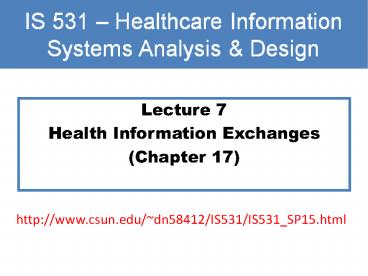Health Information Exchanges - PowerPoint PPT Presentation
1 / 28
Title:
Health Information Exchanges
Description:
Lecture 7 Health Information Exchanges (Chapter 17) Learning Objectives Health Information Exchanges (HIE) and Users Key Factors in HIE HIE Business Models Driving ... – PowerPoint PPT presentation
Number of Views:269
Avg rating:3.0/5.0
Title: Health Information Exchanges
1
- Lecture 7
- Health Information Exchanges
- (Chapter 17)
2
Learning Objectives
- Health Information Exchanges (HIE) and Users
- Key Factors in HIE
- HIE Business Models
- Driving Forces for HIE Development
- Obstacles to HIE Development
3
Health Information Exchange
4
Health Information Exchange
- Electronic movement of health-related information
among organizations, - A process within a state health information
organization or a regional health information
organization - A bidirectional sharing of patient health-related
information among providers and other authorized
healthcare professionals
5
National Health Information Network
- NHIN provides a standardized, secure, and
confidential way to link information systems
together for authorized users to share reliable
health-related information
6
Users of Health Information Exchanges
- Individual level enhance personal health
outcomes - Professional level clinical decision making
- Agency/organization level managing operations
and quality improvement - Public health and national level accreditation
bodies to evaluate population health, health
policy
7
Architecture of Heath Information Exchanges
8
Key Issues in Heath Information Exchanges
- Data storage
- Master person index (MPI)
- Record locator service
- Authentication
- Authorization
- Security policies
- Auditing and logging
- Standards
- Scope of services
- Knowledge of workflow
- Portals for access
9
Data Storage
- To enable the aggregation of data from many
sources - Infrastructure models
- Centralized
- Decentralized / federated
- Hybrid
10
Centralized Data Storage
11
Decentralized Data Storage
12
Hybrid Data Storage
13
Master Person Index (MPI)
- To uniquely identify an individual
- To match the persons data from many sources
- Could be a complex identifier with multiple
identification attributes (name, DOB, address)
14
Record Locator Service
- A service to search health information that
matches the identified individual - Locator can point to a specific types of
information / criteria
15
Authentication
- To identify authentic users to the systems
- Valid users clinical professionals, public
health professionals, supporting IT professionals
- Will include patients in future
16
Authorization
- Authorized user matrix WHO can access WHAT
information for WHAT purpose - CRUD Function Matrix in database
Create-Read-Update-Delete
17
Security Policies Procedures
- Agreement among organizations to share patient
data (retrieve, reuse) - Track requests for information(Require patient
consent) - Opt in vs. Opt out
18
Auditing Logging
- Keep track all accesses to network services
- Intentional vs. unintentional
- Connection vs. disconnection
19
Criteria-based Standards
- To assure the interoperability and reuse of
information from many sources - Data communication protocols
- Data content, format
- Technical compatibility among systems
20
Scope of Services Provided
21
Knowledge of Workflow
- Data processing procedure (When, Who, How)
- Patient data types (What, Whose)
22
Portal for Access
- Different portals for different types of
information exchanges
23
Health Information Exchange Models
- Government-led HIE direct government program
- Public utility HIE with government oversight
- Private sector-led HIE government as a
stakeholder for collaboration and advisement - Public authority HIE a government created
nonprofit authority with powers to operate in a
business-like manner
24
Health Information Exchange Business Models
- Business models designed for financial
sustainability - Membership fee model
- Transaction fee model
- Program and service fee model
25
Driving Forces
- Reduce data duplication and related costs
- Reduce discrepancies among information from may
sources and related fixing costs - Provide a uniform holistic picture of the
patients health to improve care quality - Underlying key success factor Electronic Health
Records (HER) and Electronic Medical Record (EMR)
must be first broadly adopted/implemented
26
Current Obstacles
- Size and scope of the project
- Time / Costs
- Critical mass of data to be exchange
- Collaboration between competitors (providers)
- Technical skills / necessary clinical knowledge
to use the system - Resistance to change
- Composition and structure of governing agency
27
Future Directions
- Statewide HIE initiatives have started
- HIE enabler/readiness (coordinating initiaties)
- HIE outsourcing/technical partnership (technology
implementation and services) - HIE operator (implementation and management)
- A national health information network to be build
28
Some References
- http//www.himss.org/files/himssorg/content/files/
hie/hie_guidewhitepaper.pdf - http//www.himss.org/files/HIMSSorg/content/files/
RHIO/RHIO_HIE_GeneralPresentation.pdf - http//www.health.state.mn.us/divs/hpsc/ohit/hiegu
idance/hieguide.pdf































